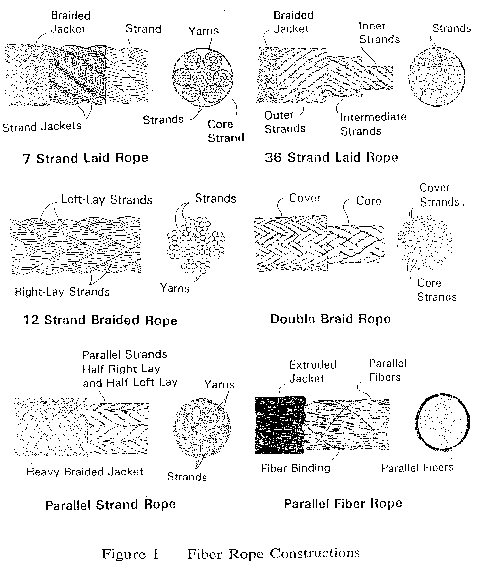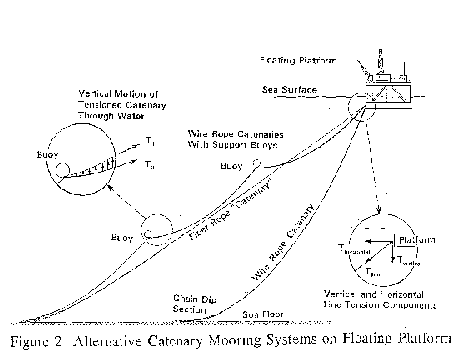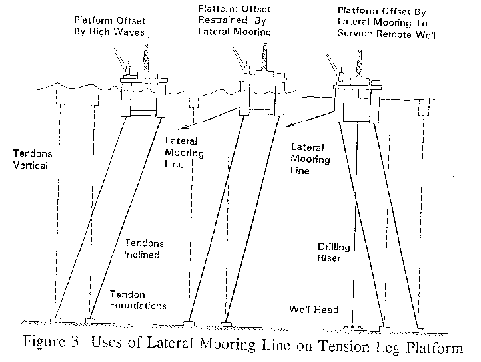Fibre Ropes For Ocean Engineering in the 21st Century
By John F. Flory, Henry A. McKenna and Mike R. Parsey
Presented at the Civil Engineering in the Oceans Conference, American Society of Civil Engineers, 1982
Abstract
Recent advances in synthetic fibre ropes will greatly influence the practice of civil engineering in the oceans during the 21st Century. New fibres have moduli almost as high as steel and are stronger than steel. Fibre ropes are light weight and easy to handle. They do not corrode. New rope and mooring system designs can compensate for the inferior wear properties of fibres and take full advantage of the other fibre properties. Some fibre ropes have tension and bending fatigue performance superior to those of wire ropes. The newer forms of fibre ropes are thus ideal for many ocean engineering applications.
Table of Contents
Introduction
Synthetic Fibre Material and Rope Properties
Conventional Rope-Making Fibres
High-Modulus Rope-Making Fibres
Rope Construction Forms
Rope Property Table
Discussion of Rope Properties
Fibre ropes in ocean engineering
Catenary Moorings in Deep Water
Tension Leg Platform Moorings
Deep-Sea Salvage
Marine Construction Projects
Considerations with the use of fibre ropes
Misconceptions About Fibre Ropes
Specifications For Fibre Ropes
Conclusions
ReferencesIntroduction
This paper is an overview of high-strength fibre ropes suitable for use in ocean engineering. The various synthetic fibre materials and rope constructions are discussed. Typical properties of these materials and of representative ropes made of them are provided. When possible, rope property data are based on tests conducted by the authors. Other property data were obtained by manufacturers or other researchers, using similar test methods. Comparisons are made of ropes of the same diameter; however, in some rope designs, variations in jacket thickness can affect such comparisons. Several present and potential applications of fibre ropes in coastal and ocean engineering are described later in the paper.
Synthetic Fibre Material and Rope Properties
Conventional Rope-Making Fibres
The three most common large synthetic-fibre rope-making materials are nylon, polypropylene, and polyester. The general properties of fibres are compared with each other and with those of steel wire in Table 1.
Nylon, also known by its chemical name polyamide, has been widely used in marine mooring and towing lines since the 1950's. It has the lowest stiffness modulus, and thus it is favoured where high extension is very important. It is the strongest of the common fibres when dry. However, wet nylon fibre loses about 10% of its strength, and wet nylon ropes can lose up to 20% of their strength. Wet nylon ropes also suffer strength loss due to creep and internal abrasion during tension cyclic loading.(Flory, 1982) The resulting short service life of large nylon ropes generally makes them unsuitable for permanent deep water moorings.
Polyester ropes are very durable in cyclic tensile fatigue loading. (Parsey, 1982, 1985) Very strong polyester rope with relatively high modulus can be made with the newer high-quality polyester fibres now available. They can be as strong as nylon when dry. Polyester ropes do not lose strength when wet and are generally stronger than nylon in wet condition. Thus polyester ropes are now supplanting nylon in many critical conventional marine applications and are good candidates for deep water mooring systems.
Polypropylene fibre is lighter than water. Polypropylene ropes are sometimes favored for this reason and for lower cost. However, polypropylene is weaker than either nylon or polyester. Polypropylene rope can heat up and lose strength during high-speed cyclic loading and may creep under high loads. Thus polypropylene is not generally suitable for deep water moorings.
Polypropylene and polyester yarns are sometimes combined in ropes. These hybrid ropes can have strength and stiffness properties similar to those of all- polyester ropes but with lower weight and cost, and they can have greater resistance to surface abrasion and heat buildup than all-polypropylene ropes.
High-Modulus Rope-Making Fibres
The term high-modulus distinguishes a class of synthetic fibres having elastic moduli significantly higher than the conventional fibres discussed above. These newer fibres also have significantly higher breaking strengths.
Aramid, the first of these new high-performance fibres, was introduced as duPont Kevlar in the early 1970s. Kevlar was soon successfully used in mooring systems for instrumentation buoys. Problems developed with Kevlar mooring lines employed on the installation barge used for the Lena project.(Riewald, 1986) The cause was subsequently identified as axial-compression fatigue, which can occur when tightly constrained aramid fibres are forced into compression. (Riewald, 1987) Kevlar mooring lines of improved designs have subsequently been used successfully on several experimental deep water platform moorings.(Koralek, 1987)
Twaron aramid fibre, made by Akzo, is essentially identical to Kevlar. Technora, a related copolymer fibre made by Teijin, has similar properties but may not be as prone to axial compression fatigue as conventional aramid fibres.
High modulus polyethylene (HMPE) is a fibre form of high-density polyethylene. The first gelspun HMPE fibre, Dyneema, was developed by DSM in the Netherlands in cooperation with Toyobo of Japan. The first commercial HMPE, Spectra, was introduced by Allied in the mid 1980s. The HMPE fibres discussed here are produced by a relatively expensive gel-spinning process. A variant formed by a melt-spinning and drawing process has lesser properties.
HMPE fibre is lighter than water. Thus it has a higher specific strength than aramid. It has a relatively low melt point. It has a tendency to creep and can rupture due to that property at sustained high loads. HMPE does not exhibit axial compression fatigue problems. It has a low coefficient of friction and has very good abrasion resistance.
A liquid crystal aromatic polyester (LCAP) fibre called Vectran was recently introduced by Hoechst Celanese.(Beers, 1990) It has been successfully used in high-performance cables and is being introduced to rope makers. This class of fibres has better resistance to axial compression fatigue and creep than aramid. At present, LCAP fibre is more expensive than aramid and HMPE, but there is potential for producing less expensive yarns by this process.
Another new class of fibre is PBO (polybenzoxazole), which was developed by the US Air Force. Dow is now producing limited quantities of PBO and is experimenting with possible applications in rope making. This more complex fibre is expensive. PBO has higher strength and higher modulus than the other synthetic polymer fibres mentioned here, with the exception of very-high modulus aramids, i.e. Kevlar 49.
The various conventional and high-modulus fibres discussed above can be constructed into usable ropes in a variety of forms. Some of the principal forms of interest to deep water moorings are shown in Figure 1 and discussed here.

Stranded ropes take a variety of forms. The 6 strand form is common to wire ropes and is also found in aramid ropes. The center is sometimes a load bearing member, and then the rope is sometimes called 7 strand. Multiple layers of strands in this form are common. The 18 strand form is not shown.
The 36 strand construction produces larger ropes while retaining small strand size. When all strand layers have the same lay length and direction, a very compact, though not necessarily the most efficient form of construction is produced. A 36 strand rope can be made essentially torque free when the direction of lay of the outer strand layer opposes of that of the inner two layers. The rope does not tend to rotate when tension is applied. However, this form of rope is not tolerant to torque, and a small amount of rotation can upset the balance of loads between inner and outer strand layers.
When used in fibre ropes, these stranded forms of construction are sometimes referred to as wire rope construction or WRC. The simplest form of WRC is the spiral or bridge strand, which is a single large strand made up of many individual wires or yarns, as shown in the figure.
Another form of construction commonly used in fibre ropes is braiding. By their nature, braided ropes are generally torque free, that is they do not tend to rotate under tension. They are not torque tolerant, because applied rotation will transfer tension to only half of the strands. However, they are not as easily affected by torque as the above mentioned 36 strand rope.
The 12 strand braided rope shown in Figure 1 is a recent development which has found wide acceptance in conventional marine applications. The familiar double-braid rope, also shown, is comprised of a core comprised of many braided strands surrounded by a load-carrying cover also of many braided strands.
The 8 strand rope, sometimes called plaited, is not shown. This construction is not as compact and thus is not as efficient on an enclosed volume basis.
All of these braided rope constructions may be suitable for deep water mooring applications in some materials. The braided construction tends to hold the rope structure together and accomplish effective load sharing among strands without an external jacket. However, they are generally less efficient and thus larger in diameter for a given strength, and the resulting higher drag can be a problem in some applications.
The strength conversion efficiency of a rope construction depends, among other things, on the angles of the fibres and yarns to the rope axis. Stranded ropes and braided ropes can be made stronger by decreasing the angles of the various components, such that they become more parallel to the rope axis. Two forms of rope construction take this practice to the limit.
The parallel strand rope, as the name implies, is made up of a number of parallel strands, sometimes called sub-ropes, enclosed in an outer jacket. These strands can have very little twist, but the preservation of a twisted-strand form provides load sharing among the component yarns and fibres and also allows for the formation of spliced terminations.
In the parallel fibre rope, also shown in Figure 1, all of the yarns are parallel to the rope axis without a twisted strand-like structure. This form of rope requires a tight jacket to bind the fibres together and provide some form of load sharing. Otherwise breaks in fibres distributed along the length of the rope would have the same effects as though they all occurred at the same point on the rope. This rope is stiff not only axially but also laterally, and thus it can not be bent and handled as easily as other forms of fibre rope. However, it is no stiffer than wire rope of the same size and strength.
Some fibre material and rope construction combinations are well suited for deep water moorings. But not all of the possible combinations of materials and constructions described here are suitable for making good ropes for all purposes.
Table 2 provides a list of engineering properties for various fibre ropes, as well as those for steel rope and rod. These values are for ropes 50 to 100 mm (2 to 4 in.) diameter, having breaking strengths of at least 1000 kN (200 kip).
Civil engineers think of material strength per unit area and also of stiffness in terms of elastic modulus per unit area. Fibre rope properties are usually given in terms of strength and extension. For convenience to engineers, the rope properties are expressed in terms of cross-section area in this table.
The rope properties in these table are for general comparison purposes only. These properties are for top-quality ropes. Some apparently similar ropes may have lower strength properties. Rope properties can not be assured without adequate rope specifications. Thus these values should not be used for design calculations without further verification, especially for critical applications.
Table 2 gives stiffness as secant modulus from essentially no load to 50% of breaking strength on the tenth cycle to that load. In a few cases, moduli have been estimated. The stiffness characteristics of most fibre ropes change with numbers of loadings, with relaxation time between loadings, and with the rate of loading. Some fibre ropes have non-linear stiffness curves. Also, the modulus of a rope can be altered greatly by changes in rope construction, for example by altering lay length. Thus the stiffness values given are only approximate.
The braided nylon and polyester ropes have similar strengths, as do the plaited ropes. Here the term braided includes both 12 strand and double-braid ropes, as these rope structures have generally similar properties. Plaited means 8 strand rope. Most conventional twisted strand ropes will have lower strengths and stiffnesses. The dry properties are listed. Most nylon ropes lose 10 to 20% strength when wet. Nylon ropes have low moduli, a desirable property for some services. Nylon ropes have non-linear stiffness characteristics, and the stiffness modulus at low loads will be even less.
The parallel strand and parallel yarn polyester ropes have higher strengths and higher moduli. Properties of a new 7 strand polyester rope design, made of high quality polyester fibre, are also given.(McKenna, 1990) This 7 strand rope has relatively low twist and does not require heavy jacketing. Thus it has properties comparable with those of the parallel strand and fibre polyester constructions.
The 36 strand aramid rope properties are those for a 90 mm dia. rope with a strength of 4500 kN (1000 kip). That rope has been extensively tested in laboratories and used experimentally on several platform moorings. A variety of other stranded aramid ropes are available with other properties. Aramid fiber is generally not suitable for making large braided ropes.
The parallel strand and parallel fibre ropes have also been extensively tested in laboratories. The parallel strand rope shown has a relatively high twist, which reduces both its strength and its modulus. Parallel fibre ropes of two different aramids are shown to demonstrate the effect of using a very high modulus form of this fibre in rope making.
HMPE fibre has potential for making ropes with strength and stiffness proper ties essentially the same as those of the aramid ropes listed here. In the available parallel strand rope data, HMPE exhibited a slightly higher strength than aramid. Comparable data for some construction forms are not yet available. Note that HMPE is suitable for braiding. The moduli shown for braided and parallel strand HMPE ropes are estimates. Both braided and 7 strand HMPE ropes are now used as mooring ropes on conventional marine vessels.
The newer synthetic fibres listed in Table 1, LCAP and PBO, have not yet been used to make large ropes. Thus no comparable rope data are available.
LCAP ropes can be expected to have strengths and stiffnesses similar to the values listed here for aramid and HMPE. LCAP ropes will not creep like HMPE ropes. Also, axial compression fatigue with LCAP is probably not as severe as with aramid.
PBO ropes can be expected to be very high strength and very stiff. They will also probably be very expensive.
The properties of two forms of steel wire rope and of a solid bar of high- strength steel are shown in the table for comparison. The 7 strand represents 6x37 IWRC wire rope, commonly used on ship's winches. The bridge strand is similar to that used as lateral guys on the Lena tower. The solid bar represents 4340 high strength structural steel.
Fibre ropes in ocean engineering
Catenary Moorings in Deep Water
Figure 2 illustrates three possible ways of mooring a floating platform in very deep water.

The traditional way of mooring in shallow water is to use steel chain or wire rope in the form of a catenary. However, as water depth increases, the angle of the catenary at the platform becomes steeper. The high vertical catenary force on the platform decreases payload or increases required buoyancy. The steep catenary initially produces very little horizontal restoring force, and excessive platform motions can result.
Another problem with catenary systems is that the chain or wire rope must move laterally through the water in response to applied tension. Long catenary lengths can not respond in this mode to rapid platform motions. The only effective elasticity in such a catenary at wave excited frequencies is that of the very- high-modulus chain or wire rope, and high mooring loads can result.
One solution is to provide intermediate supports along the chain or wire rope catenary, usually in the form of submerged buoys or flotation sleeves. Such buoyancy increases the material and installation cost of the mooring system. The system now acts as a series of catenaries. The presence of support buoys or flotation on the wire rope also increases the problems of lateral drag.
The use of light-weight, relatively low-modulus synthetic fibre mooring lines can eliminate these problems. It may be a misnomer to call such a system a catenary, since synthetic fibre ropes have little or no weight in water. The angle of the synthetic line at the platform is much shallower than with a wire rope catenary. Vertical forces on the platform are minimized. The horizontal force component is very effective in minimizing platform excursions. Almost all of the restoring force comes from mooring line elasticity, and thus wave-induced plat form motions do not produce high loads.
Recent research compared the potential performances of polyester rope and wire rope in such a lateral restraint system and concluded that polyester offered the most effective and economical alternative.(Chaplin, 1992)
Figure 3 shows the TLP (tension leg platform). This mooring system is sometimes favored for floating production systems (FPS) because it minimizes vertical motions and permits the use of simple rigid production risers.

With the TLP, it is necessary to detune the system's heave period from the predominant wave frequency. Steel wire and solid or hollow steel tendons provide sufficient stiffness to accomplish this in shallow and intermediate water depths. However, in very deep water steel tendons are not stiff enough to avoid resonance with waves. Higher elastic moduli can be achieved by the use of carbon-fibre-reinforced composite rods, but at extra cost.
An alternate approach is to use a lower modulus material, which shifts the heave period beyond the wave forcing frequency. This can be achieved by the use of polymer-fibre-reinforced rods or synthetic fibre ropes.
Guy lines can provide horizontal restraint on TLPs as well as on pivoted towers.(Littleton, 1990) (Brown, 1984) The TLP (and pivoted tower) acts like an inverted pendulum in the water, and a large net buoyancy is required to prevent excessive offset due to environmental forces. Buoyancy can be decreased, or payload can be increased, through the use of lateral guy lines. Another function of such lateral supporting tethers on TLPs is to temporarily position the platform over well heads on the ocean floor. These lateral tethers are analogous to the catenary moorings discussed above. Again, there is an advantage to using light-weight lines.
The breaking length is the limiting length of suspended rope at which its weight equals the breaking strength. The breaking length of wire rope is about 15 km in air and about 18 km in water. If a steel wire were used to lift an object in a water depth less than the breaking length, its strength efficiency is decreased in proportion to the ratio of that depth to the breaking length. The Mariana Trench is 11 km deep, and here a wire rope would only be about 40% efficient. Considering stresses caused by system dynamics, wire would be virtually worthless at this depth. Even at relatively shallow depths, the weight of steel wire compromises its effectiveness as a means of suspending and lifting weights.
For this reason, as well as others, synthetic fibre ropes are finding favour for deep-sea lift operations. The approximate breaking lengths of nylon, polyester, and aramid are 350 km, 130 km, and 300 km respectively. HMPE and polypropylene are positively buoyant in water.
A 68 mm dia. 6-strand aramid rope has been extensively tested for a proposed deep water salvage operation.(Casey, 1992) A number of such ropes in parallel, passing through a number of sheaves, were to have been used to lift a heavy sunken vessel from a water depth of about 3 km. The testing included bend-over- sheave tests at a 30:1 D/d ratio.
The US Navy has developed a special portable unit for lowering, lifting, and salvaging smaller objects in an water depth.(Liu, 1986) That system uses torque-balanced aramid ropes as large as 45 mm dia. running over a series of sheaves on a heave compensation system. Here the light-weight rope is important not only for increased efficiency as a very long suspended line, but also for portability and the ability of divers and remote-operated vehicles to handle the submerged line.
Aramid ropes were used in the positioning of work barges during construction of the Eastern Scheldt storm barrier in the Netherlands.(duPont) Very precise positioning of these barges was essential during the installation of foundation mats. Also, it was essential that the barge anchoring system did not contact and damage these mats. The light-weight, high-strength aramid ropes also were easier and faster to handle.
The largest synthetic fibre ropes ever made, 240 mm dia. nylon double braid ropes, were used to position the Hutton platform during installation of the deck.(Smith, 1985) The elasticity provided by the nylon lines reduced the ratio of peak to mean mooring loads and thus allowed an increase the mean mooring load, as compared to alternate mooring arrangements employing only chain and wire rope. The light weight of the large nylon lines was another important consideration in this choice.
Considerations with the use of fibre ropes
Misconceptions About Fibre Ropes
Ultraviolet (UV) radiation and fish bite are often mentioned as concerns for fibre rope applications in ocean engineering. These can be problems with some small ropes, but they are not apt to be problems with larger ropes.
UV radiation can degrade polypropylene and aramid fibres and to a lesser extent nylon fibres. Polyester and HMPE fibres are unaffected. Most polypropylene fibres used in rope making are treated with UV inhibitors which alleviate the problem. Almost all aramid ropes are jacketed, which protects against UV radiation.
UV radiation effects only the fibres on the surface of a rope which are exposed to sunlight. This can be significant on unprotected small ropes. However, it has virtually no effect on large ropes, even if they are untreated or unjacketed. Also, UV radiation does not penetrate into water.
Fish bite has been observed on small fiber ropes used as moorings for instru mentation buoys in some parts of the oceans. It probably is not a problem on larger ropes. Fish normally only bite on objects which they sense is food. They are sometimes attracted by a small vibrating rope or a small object streaming from a small rope, thinking it is food. Large ropes are much less apt to appear to be food. Also, few fish can bite down on a large rope.
Where fish bite is known or thought to be a problem, the fibre rope can be jacketed and armored. The jacket normally placed on some fibre ropes will serve as protection. Similar jacketing is placed on some wire ropes in ocean service to protect against sea water penetration and corrosion. Fish bite damage which penetrates such a jacket will have little effect on a synthetic fibre rope. Such sea water penetration in a wire rope will result in corrosion and possible failure.
Specifications For Fibre Ropes
Care should be exercised in specifying fibre ropes for critical applications, just as with any other critical component. Specifying rope by its strength and stiffness modulus, as for example listed in Table 2, is not sufficient.
There are many national and international standards for conventional fibre ropes.(Flory, 1987) The existing standards do not cover rope made with the high- modulus fibres, not do they cover some of the less common rope structures. These standards generally represent only the minimum properties to which a group of manufacturers agree they can meet. Much better ropes of the conventional fibres and constructions can be obtained by using adequate specifications and being willing to pay for quality and performance.
When specifying ropes and when comparing properties presented by various manufacturers, the rope property data should based on the same test procedures. It is important to understand if the break strength is wet or dry. The method of terminating the test specimen, the length of test specimen, and the rate of loading are other important factors. Rope extension test data will depend on the number of load cycles, on the rate of loading, and on relaxation time. Also, the definition of extension and the way in which it is measured are important.
The OCIMF Hawser Guidelines are an excellent basis for specifying, testing, purchasing, and inspection large synthetic fibre ropes.(OCIMF, 1987)(Flory, 1988) These procedures call for documentation of a specific rope design, manufacturing and prototype testing, and quality assurance procedures to determine that the final rope product is the same as the tested prototype.
The performance of most synthetic fibres can be enhanced by the application of proprietary finishes. Fibres with special marine finishes are especially important in nylon and polyester ropes.(Flory, 1990) It is important to assure that the same fibre finish is used in a production rope as was used on test specimens.
Conclusions
Synthetic fibre ropes will have prominent roles in civil engineering in the oceans in the next century. Wire rope has limitations, particularly heavy weight and susceptibility to corrosion. Fibre reinforced composite rods are inflexible, expensive, and hard to assemble and handle in long lengths. Fibre ropes over come these and other problems in the design and installation of deep ocean structures and moorings.
The conventional rope-making fibres, especially polyester, will serve where diameter need not be minimized and where moderate extension can be tolerated or even is desirable. The high modulus fibres — aramid, HMPE, and LCAP — will have many roles, especially as rope making techniques for these fibres develop. Newer fibres — PBO and others not yet announced or even discovered — will probably offer different and even better properties, enabling fibre ropes to serve even more demanding functions in the oceans.
References
Beers, D.E., and J.E. Ramirez, "Vectran Fibre For Ropes and Cables", MTS Conference '90, MTS, Washington, Sept. 1990, pp 662-670.
Brown, C.P., L.M Fontenette, and P.G.S. Dove, "Installation of Guying System - Lena Guyed Tower", OTC 4682, 1984 Offshore Technology Conference Proc., Houston, May 1984, pp 309-318.
Casey, N.F., N.D. Robertson, and J. Wells, "The Evaluation of Synthetic Fibre Rope for a Proposed Deep Water Salvage Operation", presented at `A Review of Current Develop ments in Offshore Ropes', June, 1992, Society of Underwater Technology, London.
Chaplin, C.R., and C.J.M. Del Vecchio, "Appraisal of Lightweight Moorings for Deep Water", OTC 6965, 1992 Offshore Technology Conference Proc., OTC, Houston, May 1992, pp 189-199.
... duPont, "Cables of Kevlar help secure construction vessels at world's largest storm barrier", `Kevlar Case History', E.I. DuPont Co., Wilmington.
Flory, J.F., Hawser Test Report, Oil Companies International Marine Forum, Witherby and Co. Ltd., London, April 1982.
Flory, J.F., "International and National Standards for Large Synthetic-Fibre Ropes", OTC 5382, 1987 Offshore Technology Conference Proc., Houston, May 1987, pp 233-244.
Flory, J.F., "OCIMF Hawser Guidelines and Procedures", OTC 5721, 1988 Offshore Technology Conference Proc., Houston, May 1988, 351-356.
Flory, J.F., J.W.S. Hearle, and M. Goksoy, "Yarn Friction and Abrasion Characteristics as Indicators of Rope Performance in Marine Environments", MTS '90 Conference Proc., Marine Technology Society, Washington, DC, Sept. 1990, pp 313-318.
Koralek, A. and J.K. Barden, "Performance of a Lightweight Aramid Mooring Line", OTC 5381, 1987 Offshore Technology Conference Proc., Houston, May 1981, pp 221-231.
Littleton, J., "Shell's Auger TLP Demonstrates Cost Insensitivity as Depths Increase", Offshore, Tulsa, Vol 50, No 1, Jan 1990, pp 28-29, 50, 55.
Liu, F.C., "Fly Away Deep Ocean Salvage System (FADOSS) - A Compensated Lift System, Current Practices and New Technology in Ocean Energy, ASME, Feb. 1986, OED Vol 11, pp 403-409.
McKenna, H.A., "High performance Polymer Ropes", MTS '90 Conference Proc., Marine Technology Society, Washington, DC, Sept, 1990, pp 657-662.
... OCIMF, Guide to Purchasing Hawsers, Prototype Rope Testing, and Procedures for Quality Control and Inspection during the Production of Hawsers, Oil Companies International Marine Forum, Witherby & Co., London, 1987 (3 volumes).
Parsey, M.R., "Fatigue of SPM Mooring Hawsers", OTC 4307, 1982 Offshore Technology Conference Proc., Houston, May, 1982, Vol III, pp 71-93.
Parsey, M.R., A. Street, and S.J. Banfield, "Dynamic Behaviour of Marine Hawsers", OTC 5009, 1985 Offshore Technology Conference Proc., Houston, May 1985, pp 429-443.
Riewald, P.G., "Performance Analysis of an Aramid Mooring Line", OTC 5187, 1986 Offshore Technology Conference Proc., Houston, May, 1986, pp 305-316.
Riewald, P.G. , R.G. Walden, A.S. Whitehill and A.S. Koralek, "Design and Deployment Parameters Affecting the Survivability of Stranded Aramid Fibre Ropes in the Marine Environment", Oceans '87 Proc., IEEE & MTS, October, 1987, pp 284-293.
Smith, I., G.J. White, and C.S. Collings, "Synthetic Rope in the Mooring System of the Hutton TLP", OTC 5063, 1985 Offshore Technology Conference Proc., Houston, May 1985, pp 391-402.
Fibre Rope paper
YOU ARE IN PAPERS

/NQA-ISO-9001-Logo-UKAS.jpg)
/NQA-ISO-45001-Logo-UKAS.jpg)
